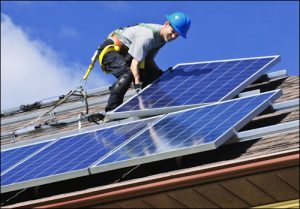Solar co-ops are popping up all around Virginia, as they are around the country. The concept is simple: Individuals who want to install solar power on their houses band together to select a single contractor to install their solar systems, saving up to 20% to 30%.
The Virginia Solar United Neighborhoods (VA SUN) website lists open co-ops in Northern Virginia, Richmond and Farmville and closed co-ops in nine other Virginia locations.
In an era of fast-improving solar efficiency and near-zero interest rates, the economics of residential solar look attractive. VA SUN advises that nine- to twelve-year paybacks (including the 30% federal tax credit) are typical. That implies a relatively low-risk return on investment in the neighborhood of 7% to 9%, which is better than most people can get parking their money in bank CDs or U.S. Treasuries and a lot less risky than investing in the stock market.
Bacon’s bottom line: While I’m skeptical of promoting solar energy production in Virginia through mandatory Renewable Portfolio Standards, I’m a big fan of innovators who improve the economics of solar and drive down the cost of installation. I could see myself giving serious thought to installing solar on my own house. (A decisive factor for me would be determining how many trees I’d have to cut down. Tree-cutting services charge charge a small fortune!)
Residential solar accounts for such a small percentage of the electric-generating capacity in Virginia that it doesn’t pose a problem for the stability and reliability of the electric grid. Yet. That could change as rooftop-solar becomes more ubiquitous. Solar homeowners and businesses like selling surplus electricity into the electric grid, and they like drawing upon the grid when the sun isn’t shining. They also like not paying a fair share of the cost of maintaining the grid that guarantees them a 24/7 supply of electricity. At some point rooftop solar could extend to so many customers that would undermine the financial integrity of the electric grid.
We’re nowhere near that point now, but we could get there. It would be prudent to start thinking now about what a next-generation grid capable of accommodating hundreds of thousands of solar rooftops would look like, and what would be reasonable for solar households to pay to support it.
— JAB



